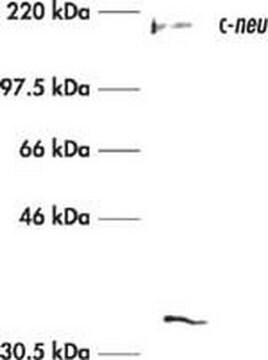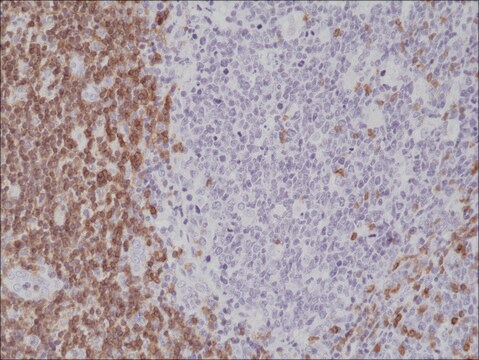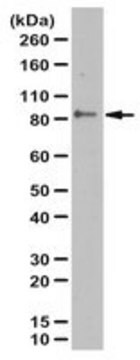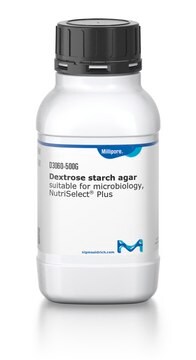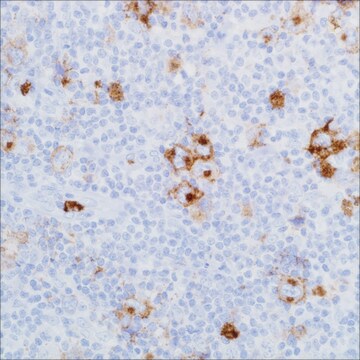ABE1859
Anti-KAP-1/TRIM28 Antibody
serum, from rabbit
Sinónimos:
Transcription intermediary factor 1-beta, TIF1-beta, E3 SUMO-protein ligase TRIM28, KRAB-associated protein 1, KAP-1, KRAB-interacting protein 1, KRIP-1, Nuclear corepressor KAP-1, RING finger protein 96, Tripartite motif-containing protein 28, KAP-1/TRI
About This Item
Productos recomendados
origen biológico
rabbit
Nivel de calidad
forma del anticuerpo
serum
tipo de anticuerpo
primary antibodies
clon
polyclonal
reactividad de especies
mouse, human
técnicas
immunocytochemistry: suitable
immunoprecipitation (IP): suitable
western blot: suitable
Nº de acceso NCBI
Nº de acceso UniProt
Condiciones de envío
dry ice
modificación del objetivo postraduccional
unmodified
Información sobre el gen
mouse ... Trim28(21849)
Descripción general
Kruppel-associated box-/KRAB-associated protein 1 (KAP-1) is a transcriptional co-repressor that selectively targets the KRAB domain of zinc finger protein-based transcription factors with its N-terminal tripartite RBCC (RING, b-box, coiled-coil) domain. KAP-1 uses its C-terminal PxVxL motif and the PHD-Bromo domain to recruit chromatin modifiers, such as heterochromatin protein 1 (HP-1), Histone-lysine N-methyltransferase SETDB1, nucleosome remodeling and deacetylation (NuRD) complex, and histone deacetylases (HDACs), for transcriptional repression. KAP-1 also plays an essential role in the DNA damage response (DDR). Upon DNA damage, KAP-1 is rapidly phosphorylated by Ataxia telangiectasia mutated (ATM) on Ser824, causing chromatin relaxation to facilitate DNA repair. In addition, SIRT1-mediated KAP-1 deacetylation is reported to stabilize KAP1 and 53BP1 interaction, resulting in an enhancement of NHEJ-mediated repair efficiency in a KAP-1 pSer824-independent manner.
Especificidad
Inmunógeno
Aplicación
Epigenetics & Nuclear Function
Nuclear Receptors
Western Blotting Analysis: A representative lot detected similar level of endogenous KAP-1/Trim28 in HEK293T cells regardless of ionizing radiation treatment or shRNA-mediated SirT1 downregulation (Lin, Y.H., et al. (2015). PLoS One. 10(4):e0123935).
Western Blotting Analysis: A representative lot detected KAP-1/Trim28 in whole cell lysates, but not in BAP1, FoxK1, or FoxK2 immunoprecipitate (Okino, Y., et al. (2015). J. Biol. Chem. 16;290(3):1580-1591).
Immunoprecipitation Analysis: 10 µL from a representative lot immunoprecipitated KAP-1/Trim28 from HEK293T cell lysates (Courtesy of Dr. Zhenkun Lou, Mayo clinic, Rochester, MN).
Immunocytochemistry Analysis: An 1:1000 dilution from a representative lot detected KAP-1/Trim28 nuclear localization in U2OS cells (Courtesy of Dr. Zhenkun Lou, Mayo clinic, Rochester, MN).
Immunoprecipitation Analysis: A representative lot co-immunoprecipitated SirT1 with KAP-1/Trim28 from HEK293T cell lysates (Lin, Y.H., et al. (2015). PLoS One. 10(4):e0123935).
Western Blotting Analysis: An 1:1000 dilution from a representative lot detected KAP-1/Trim28 in mouse embryonic fibroblast (MEF) lysate, as well as downregulated KAP-1/Trim28 in lysates from KAP1 siRNA-treated HEK293T cells (Courtesy of Dr. Zhenkun Lou, Mayo clinic, Rochester, MN).
Calidad
Western Blotting Analysis: A 1:2,000 dilution of this antibody detected KAP-1/TRIM28 in 10 µg of HEK293T cell lysate.
Descripción de destino
Forma física
Almacenamiento y estabilidad
Handling Recommendations: Upon receipt and prior to removing the cap, centrifuge the vial and gently mix the solution. Aliquot into microcentrifuge tubes and store at -20°C. Avoid repeated freeze/thaw cycles, which may damage IgG and affect product performance.
Otras notas
Cláusula de descargo de responsabilidad
¿No encuentra el producto adecuado?
Pruebe nuestro Herramienta de selección de productos.
Código de clase de almacenamiento
12 - Non Combustible Liquids
Clase de riesgo para el agua (WGK)
WGK 1
Punto de inflamabilidad (°F)
Not applicable
Punto de inflamabilidad (°C)
Not applicable
Certificados de análisis (COA)
Busque Certificados de análisis (COA) introduciendo el número de lote del producto. Los números de lote se encuentran en la etiqueta del producto después de las palabras «Lot» o «Batch»
¿Ya tiene este producto?
Encuentre la documentación para los productos que ha comprado recientemente en la Biblioteca de documentos.
Nuestro equipo de científicos tiene experiencia en todas las áreas de investigación: Ciencias de la vida, Ciencia de los materiales, Síntesis química, Cromatografía, Analítica y muchas otras.
Póngase en contacto con el Servicio técnico
